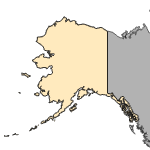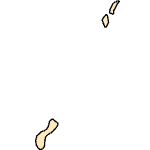Etheostoma nuchale
(Watercress Darter)
Fishes
Native Transplant |
|
Common name: Watercress Darter
Taxonomy: available through
www.itis.gov
Identification: Page (1983); Page and Burr (1991); Mettee et al. (1996).
Size: 5.4 cm.
Native Range: Thomas', Roebuck, Glenn, and Seven springs in the Black Warrior drainage, Jefferson County, Alabama (U.S. Fish and Wildlife Service 1992, 2009; Duncan et al. 2010).



|

Alaska |

Hawaii |

Puerto Rico &
Virgin Islands |

Guam Saipan |
Hydrologic Unit Codes (HUCs) Explained
Interactive maps: Point Distribution Maps
Nonindigenous Occurrences:
Table 1. States with nonindigenous occurrences, the earliest and latest observations in each state, and the tally and names of HUCs with observations†. Names and dates are hyperlinked to their relevant specimen records. The list of references for all nonindigenous occurrences of Etheostoma nuchale are found here.
Table last updated 12/18/2025
† Populations may not be currently present.
Ecology: Inhabits slow moving spring pools and associated runs; primarily associated with aquatic vegetation (e.g., watercress) where it feeds and reproduces (Boschung and Mayden 2004; Duncan et al 2010).
Means of Introduction: The species was originally stocked to create a second population. At the time of the original introduction, the species was known only from Glenn Springs. That site was immediately adjacent to Jefferson County Route 20, and would have been imperiled by any road expansions. In 1965, 43 specimens from Glenn Springs were stocked in Prince Springs in hope that a second population would afford the species more security (U.S. Fish and Wildlife Service 1980a; Howell, personal communication). The Watercress Darter was listed as a federally endangered species in 1970 (U.S. Fish and Wildlife Service 1980a). The species was later discovered at two other sites during a survey conducted between 1977 and 1978. During the period 1976-1977, all three native populations were at risk. Glenn Springs deteriorated because of sewage contamination; Thomas' Spring was to be dredged, the sportfish removed and then replaced with catfish; and the Roebuck Springs population contracted "gas bubble" disease (U.S. Fish and Wildlife Service 1980a). On 19 January 1988, 400 fish were transplanted from Roebuck Springs, 200 to Tapawingo Springs and 200 to Avondale Springs, as part of an endangered species recovery plan designed to save this species from extinction (U.S. Fish and Wildlife Service 1992).
Status: Established at Tapawingo Springs (Howell, personal communication). Failed at Prince Springs, possibly due to competition from redfin darters E. whipplei (U.S. Fish and Wildlife Service 1992). Sampling the year after the initial transplant failed to find any individuals. Additional sampling trips in the past ~30 years also have failed to find any individuals (Howell, personal communication). The transplant is believed to also have failed at Avondale Springs (Howell, personal communication). No individuals have been recovered; however, the site is difficult to sample (U.S. Fish and Wildlife Service 1992).
Impact of Introduction: The introduction of Watercress Darters to Tapawingo Springs caused the extirpation of rush darter (E. phytophilum), a Federally Endangered species of darter described in 1999, at that locality (George et al. 2009)
References: (click for full references)
Boschung, H.T., and R.L. Mayden. Fishes of Alabama. Smithsonian Books, Washington, DC.
Duncan, R.S., C.P. Elliott, B.L. Fluker, and B.R. Kuhajda. 2010. Habitat use of the watercress darter (Etheostoma nuchale): an endangered fish in an urban landscape. American Midland Naturalist 164:9-21.
George, A.L., B.R. Kuhajda, J.D. Williams, M.A. Cantrell, P.L. Rakes, and J.R. Shute. 2009. Guidelines for propagation and translocation for freshwater fish conservation. Fisheries 34(11):529-545.
Mettee, M.F., P.E. O'Neil, and J.M. Pierson. 1996. Fishes of Alabama and the Mobile Basin. Oxmoor House, Inc., Birmingham, AL.
Page, L.M. 1983. Handbook of darters. T.F.H., Inc., Neptune City, NJ.
Page, L.M. and B.M. Burr. 1991. A field guide to freshwater fishes of North America north of Mexico. The Peterson Guide Series, vol. 42. Houghton Mifflin Company, Boston, MA.
U.S. Fish and Wildlife Service. 1980. Watercress darter (Etheostoma nuchale) recovery plan. U.S. Fish and Wildlife Service, Jackson, MI.
U.S. Fish and Wildlife Service. 1992. Watercress darter (Etheostoma nuchale) recovery plan. U.S. Fish and Wildlife Service, Jackson, MI.
U.S. Fish and Wildlife Service. 2009. Watercress darter (Etheostoma nuchale). Five year review: summary and evaluation. U.S. Fish and Wildlife Service, Jackson, MI.
Other Resources:
Watercress darter - Outdoor Alabama
FishBase Summary
Author:
Pam Fuller, and Matt Neilson
Revision Date: 11/20/2015
Peer Review Date: 11/20/2015
Citation Information:
Pam Fuller, and Matt Neilson, 2025, Etheostoma nuchale Howell and Caldwell, 1965: U.S. Geological Survey, Nonindigenous Aquatic Species Database, Gainesville, FL, https://nas.er.usgs.gov/queries/FactSheet.aspx?SpeciesID=815, Revision Date: 11/20/2015, Peer Review Date: 11/20/2015, Access Date: 12/19/2025
This information is preliminary or provisional and is subject to revision. It is being provided to meet the need for timely best science. The information has not received final approval by the U.S. Geological Survey (USGS) and is provided on the condition that neither the USGS nor the U.S. Government shall be held liable for any damages resulting from the authorized or unauthorized use of the information.